Let’s talk shop about gardening tools!
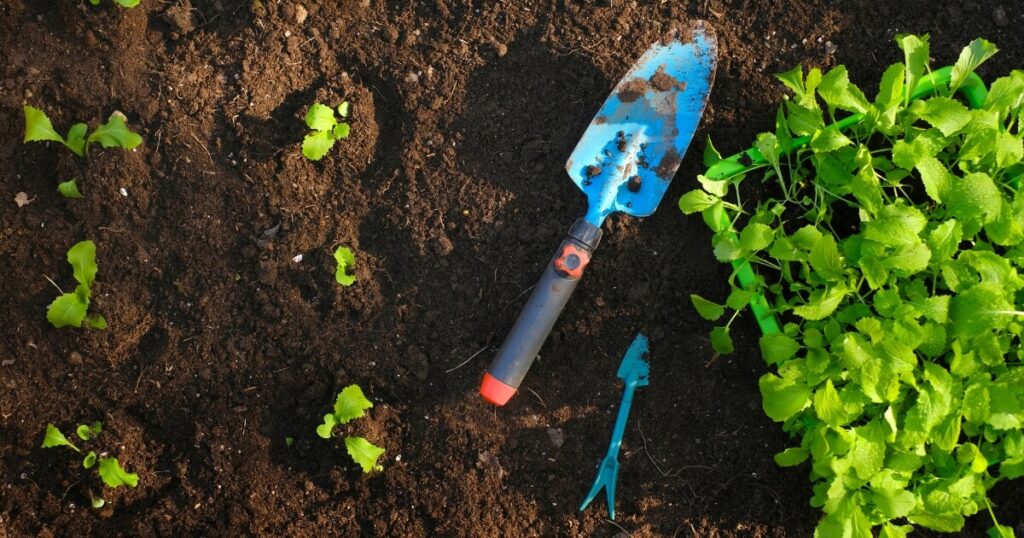
Now, I’m not saying you need every gadget under the sun—just that solid basics can go a long way. Let’s get our hands dirty and explore some of my favorite gardening tools that will make your life easier and help you keep your garden in top shape.
What I’ve Learned About Buying Gardening Tools
Over my years of gardening, I’ve picked up a few tricks about choosing and caring for tools. Here’s the real scoop from one gardener to another:
- Be a Smart Shopper, Not a Spontaneous One: It’s tempting to grab every shiny tool in the store, but trust me, not every tool is a must-have. Think about what you really need.
- A Little TLC Goes a Long Way: I used to toss my tools in the shed and forget them till next spring. Big mistake. Now I give them a quick cleaning after each use, and they last way longer.
- Storage is Key: I store all my tools in a dry shed. If you’re short on space, hanging them on a wall or storing them in a waterproof container can make a huge difference.
- Think About Comfort: Choose tools with comfortable grips and the right size for your strength and height. Your body will thank you.
- Quality Over Quantity: It’s easy to fall for cheap tool sets, but I’ve been there, and they don’t last. Investing a bit more in a few high-quality tools is way better than replacing cheaper ones every year.
And hey, there’s nothing wrong with treating yourself to that one fancy tool you’ve been eyeing – if you’re going to use it, of course!
So, for everyday gardening, I like cloth gloves with a rubber or latex grip like the DOFOWORK Gardening Gloves. The best part is that they come in multipacks, so you can have a fresh pair ready to go.
Garden Gloves
The first thing I always recommend is a good pair of gardening gloves. I can’t tell you how many times I’ve cut myself from digging with bare hands or blisters from using a shovel. They’ll also protect your hands from thorns, splinters, and soil-borne irritants.
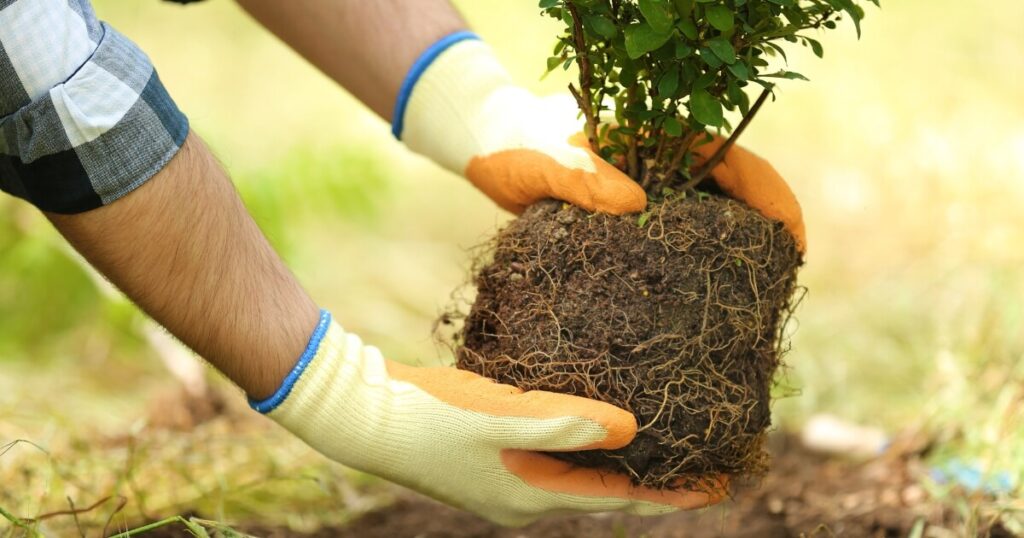
Gloves that are too big can slip off or make it hard to grasp tools properly, and if they are too tight, they’ll restrict movement and possibly cause blisters.
So, for everyday gardening, I like cloth gloves with a rubber or latex grip like the DOFOWORK Gardening Gloves. The best part is that they come in multipacks, so you can have a fresh pair ready to go.
TYPES
- Leather Gloves: Durable and tough, ideal for handling thorny plants or rough materials.
- Waterproof Gloves: Made with materials like rubber or neoprene, they keep hands dry when working with water or wet soil.
- Cloth Gloves: Breathable and lightweight, suitable for light tasks where dexterity is needed.
BEST USES
- Handling Thorns and Prickly Plants: Leather gloves provide a sturdy barrier against sharp edges.
- Working in Wet Conditions: Waterproof gloves prevent soggy fingers when watering or dealing with damp soil.
- Delicate Tasks: Cloth gloves offer the most tactile sensitivity for tasks like seed planting or thinning seedlings.
I hand wash all of my cloth gloves in a bucket of warm, soapy water because there is no way my wife would let me get away with tossing any of my gardening equipment in the washing machine. If your gloves develop holes or become too soiled, they’re cheap enough to replace to keep your hands protected.
Trowel
A hand trowel is there when you need to dig into action, whether that’s for planting a new bed of flowers or vegetable seedlings or going on a weed-pulling spree. If you’re just getting started, a standard trowel is good for most uses around the garden.
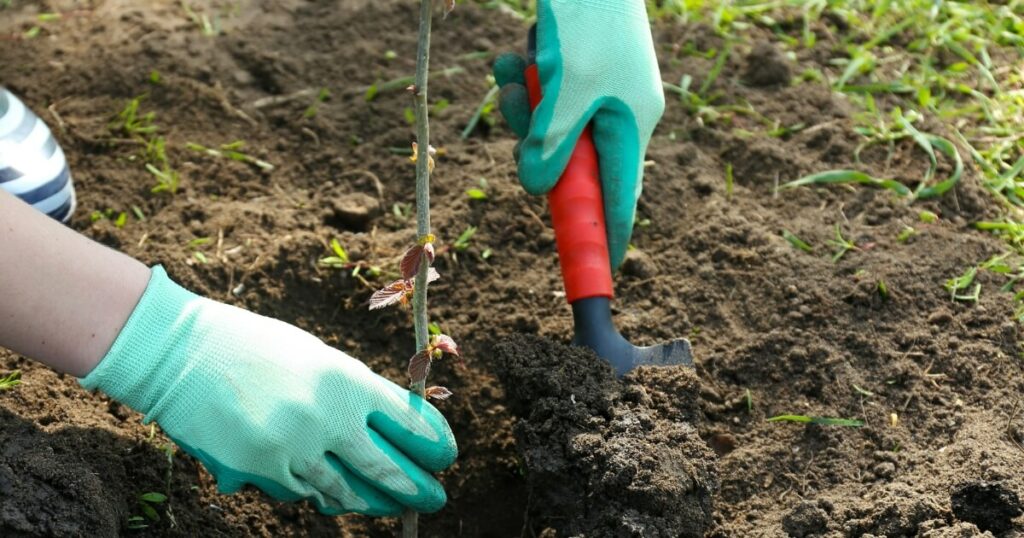
I like rubber handles, like the Edward Tools Garden Trowel has, because even with a good pair of gloves on, a comfortable grip feels more like an extension of my hand. But the most important feature is a sturdy metal blade (stainless steel is a good bet) that can handle rocky soil and roots without bending or breaking.
TYPES
- Standard Trowel: Your go-to for general gardening tasks.
- Transplanting Trowel: Narrower and longer, perfect for moving plants without disturbing their neighbors.
- Potting Trowel: A wide and sturdy scoop for easily potting and repotting.
BEST USES
- Planting: Scooping out the perfect home for seedlings.
- Transplanting: Moving plants without causing root shock.
- Potting: Filling pots with soil without making a mess.
- Digging Small Holes: Ideal for bulbs and small plants.
I always clean trowels after each use because dried-on dirt can make it less effective and can spread disease. Usually, a quick spray with the hose and hanging it somewhere to dry is good enough. If the blade doesn’t have a coating, a quick sharpening annually keeps it slicing through the soil like butter. And if it has a wooden handle, I recommend giving it an occasional rub-down with linseed oil to prevent splitting.
Pruners
Pruners are excellent for trimming and shaping your plants to help them grow strong and produce well.

Well-maintained pruners make cleaner cuts, which heal faster on plants. And while it might be tempting to try cutting wire, don’t. It’s not what they’re made for, and you’ll only end up with dull blades or a broken tool!
You’ll need pruners that fit comfortably in your hand because you’ll struggle if they’re too large. If they’re too small, you won’t get enough leverage. Even though I have pretty good grip strength, I prefer to look for no-slip handles to keep things steady during precision work.
The Gerossi Bypass Pruning Shears fit these criteria for cutting and snipping anything in your yard.
TYPES
- Bypass Pruners: Think of these as scissors for your plants, great for precise cuts.
- Anvil Pruners: These are best for dead wood with a single straight blade that closes onto a flat edge.
- Ratchet Pruners: These have a mechanism that cuts in stages, making it easier on your hands.
BEST USES
- Trimming: Keeping plants healthy by removing dead or overgrown branches.
- Shaping: Creating the perfect form for hedges and topiaries.
- Cutting Thick Stems: Getting through tough growth without damaging the plant or your hand.
You’ll find that I recommend cleaning a lot throughout this guide to prevent disease spread. So, wipe down the blades with alcohol wipes and store them in a dry place to avoid rusting. And keep them sharp because a dull blade can damage your plants and make them harder for you to use.
Weeding Tool
Who appreciates weeds in their garden? Not me! They compete with your plants for nutrients and sunlight, but a weeding tool can help you show them the door.
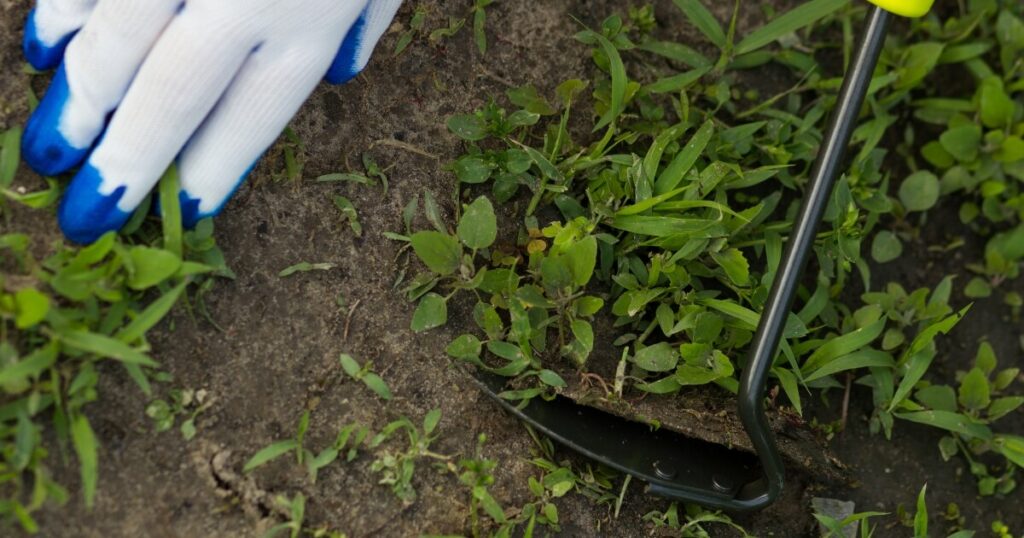
Comfort is king when you’re waging war on weeds. I prefer a long-handle stand weeder for lawn work, but you need to get up close in the garden.
Look for tools with ergonomic handles to reduce strain on your wrist and forearm. The Cobra Head Weeder is a cape-cod-style weeder that is made of lightweight materials to make it easier to keep going until you’ve cleared the last of those pesky invaders.
TYPES
- Cape Cod Weeder: A curved blade great for getting under weeds and slicing through their roots.
- Fishtail Weeder: Its V-shaped tip is perfect for prying out dandelions and other deep-rooted troublemakers.
- Hoe: Old-school but effective, a hoe chops down weeds and can also shape the soil.
BEST USES
- Surface Weeds: The Cape Cod weeder is excellent for skimming just below the soil line to cut weeds off at the pass.
- Deep Roots: Reach for a fishtail weeder when you’re up against stubborn roots that won’t budge easily.
- Larger Areas: Use a hoe to cover more ground quickly. Ideal for vegetable gardens or larger flower beds.
Keep your weeding tools sharp, clean them after use, and store them properly. A well-cared-for tool makes the job smoother and keeps you in control of your garden’s guest list. Only plants with an invite should be enjoying your hard work!
Shovel
Shovels and spades are your go-to when you need to move mountains or at least a mountain of soil. These are the heavy lifters in gardening, perfect for when your garden calls for some serious excavation or renovation.
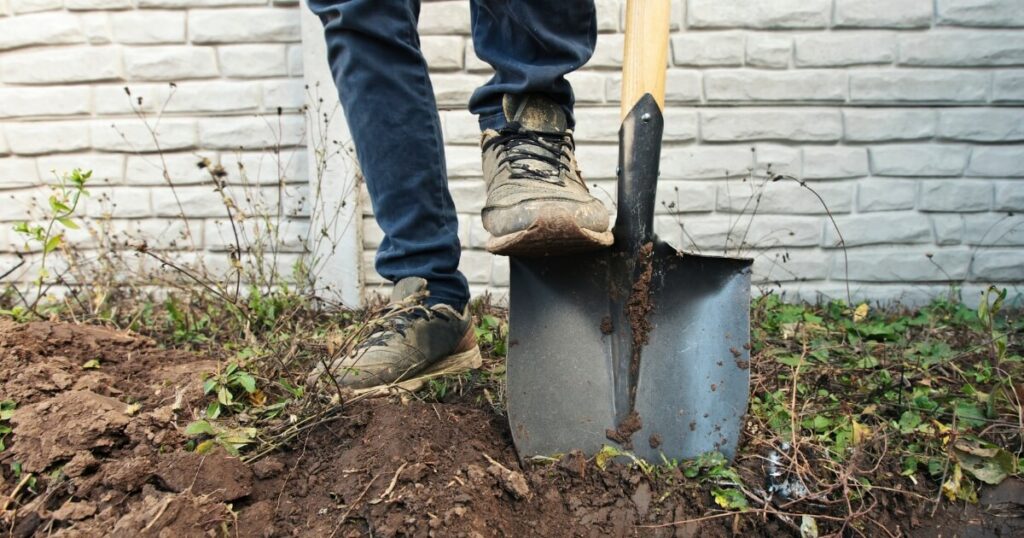
A round point shovel with a long handle is my go-to, but the most important feature to me is the blade material. Steel is strong but heavier, while aluminum is lighter and less durable.
I think the Bully Tools shovel, which has a steel blade and lips at the top of the blade for stepping on, is a great choice. But, here are a few more of my favorite garden shovels for you to compare.
TYPES
- Round Point Shovel: This is the classic shovel with a rounded, slightly pointed end, ideal for digging and breaking up soil.
- Garden Spade: A flatter, straight-edged tool designed for slicing through turf and edging beds.
- Border Spade: Smaller than a garden spade, it’s meant for tight spaces and precise work.
BEST USES
- Digging: The round point shovel digs holes and trenches like a champ.
- Edging: Garden spades create crisp lines around flower beds.
- Soil Moving: Both shovels and spades can scoop and transfer soil or compost.
At some point, you’ll need to sharpen the edges of your spade or shovel to keep them cutting cleanly through soil and roots. Store them in a dry place to prevent wood handles from rotting or metal corroding.
Garden Fork
Garden forks are not just for aerating soil or turning compost but also handy for digging up root crops like potatoes without damaging them from compacting the soil like a shovel would.
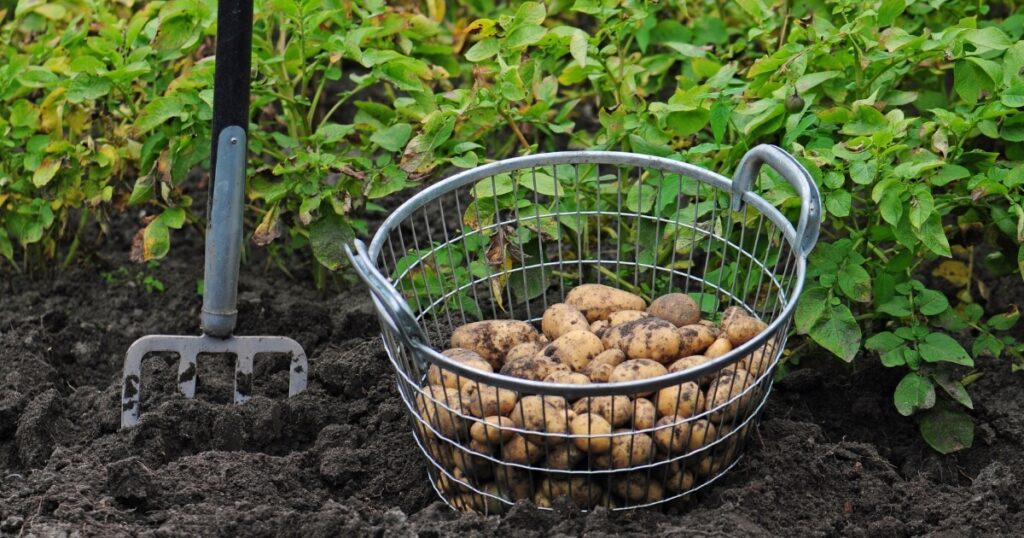
If you already have a hand trowel that can do small forking jobs well enough, you can skip the hand version and go big with the Radius Garden Digging Fork.
When picking out a garden fork, pay attention to the strength of the tines. Steel is your best bet for durability because it’ll withstand repeated use in tough soil without bending. I like the D-handle style, which makes it easier to pull out of the ground when stuck.
TYPES
- Digging Fork: A sturdy fork with four sharp tines, perfect for turning over soil.
- Border Fork: A smaller version of the digging fork, designed for use in tighter spaces or raised beds.
- Compost Fork: Its thinner and sometimes flatter tines are designed to help you turn and spread compost.
BEST USES
- Aerating Soil: Digging forks can introduce air into compacted soil, promoting healthy root growth.
- Turning Compost: Compost forks mix compost piles efficiently, helping speed up decomposition.
- Breaking Up Clumps: The sharp tines of garden forks are great at breaking up heavy soil or clay into workable earth.
Regular maintenance includes cleaning off any stuck-on dirt and storing your fork in a dry place to prevent rusting. If you’re dealing with particularly resistant earth or stubborn roots, remember that while garden forks are strong, they’re not invincible. Apply force wisely to avoid snapping a tine.
Rake
Rakes are essential for keeping your outdoor space neat and orderly.
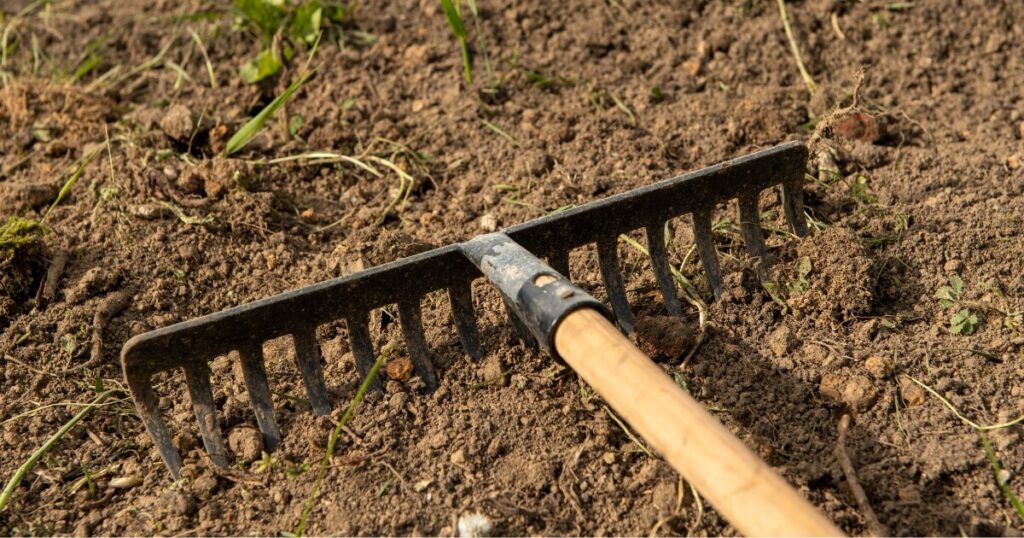
When selecting a gardening rake, consider the handle length. It should allow you to stand upright to avoid back pain. Usually, around chest height is good. As for tine material, metal tines are durable and ideal for heavy-duty tasks like soil prep. The Walensee Bow Rake is 5.4 feet tall, which is perfect for me as I’m 6.1 feet tall.
TYPES
- Leaf Rake: Typically made with flexible tines, this fan-shaped rake is designed to gather leaves without damaging your lawn.
- Garden Rake: With its sturdy metal tines, this rake is a pro at breaking up soil and removing rocks.
- Landscape Rake: A wide rake that’s perfect for leveling soil or spreading mulch over large areas.
BEST USES
- Gathering Leaves: Use a leaf rake to collect fallen foliage without straining your back.
- Smoothing Soil: A garden rake can create a level surface, preparing beds for planting.
- Removing Debris: Landscape rakes are great for clearing twigs, stones, and other unwanted material from your garden.
Keep your rakes in good condition by cleaning them after use and storing them indoors. Metal tines may need occasional straightening if they get bent out of shape, but you’ll need to do so gently to avoid breakage.
Garden Hose
Water is the lifeblood of any garden, and a good hose is the perfect delivery system that keeps our plants sipping happily. As a beginner, I don’t recommend using a soaker hose until you’ve really mapped out your garden and have some experience.
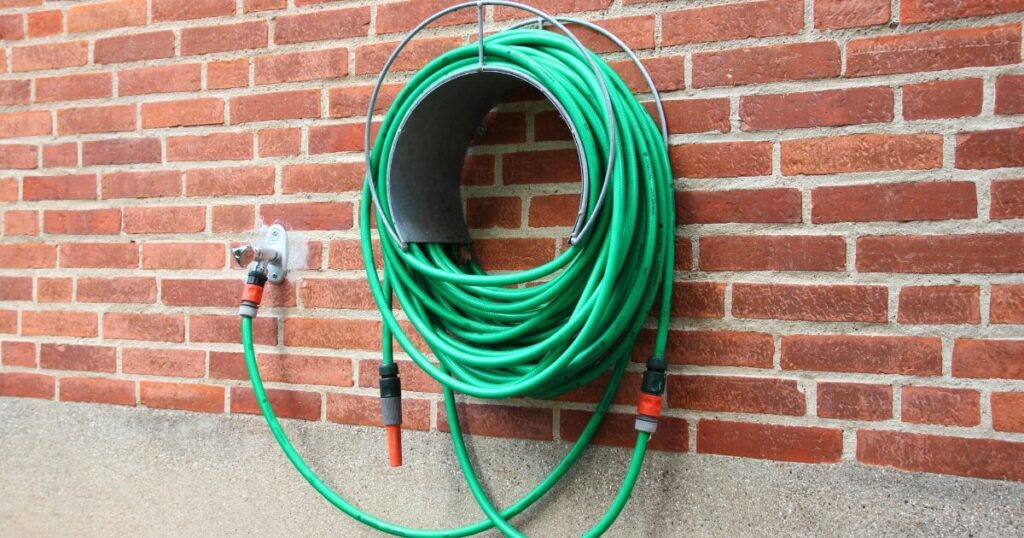
Plus, a regular garden hose can be used for other things like washing the car, the side of the house, your tools, etc.
When choosing a hose, consider its length. You want one long enough to reach all areas of your garden but not so long that it becomes unwieldy unless you also use a hose reel. I like to go big, and the Flexzilla Garden Hose comes in at 100 feet long! If you find that that’s not enough, just add a second.
As for nozzles, you should have at least one, and there’s a variety to suit every task:
- Spray Nozzles offer different patterns, from a gentle mist for delicate flowers to a strong jet for cleaning tools.
- Wand Attachments extend your reach and are great for watering hanging baskets or hard-to-reach plants.
- Dial Nozzles let you adjust the water flow right at your fingertips.
TYPES
- Expandable Hoses: These stretch out when filled with water and shrink back for easy storage.
- Soaker Hoses: Designed to lie on or under the ground, they slowly trickle water directly into the soil.
BEST USES
- Watering Plants: Expandable hoses reach far corners of your garden without being cumbersome.
- Soaking Beds: Soaker hoses provide deep watering that’s ideal for root systems.
To keep your hoses in top shape, drain them after use if you can and store them away from direct sunlight. This helps prevent cracks and preserves their elasticity.
Sprinkler
I love sprinklers because you can kick back a little knowing your garden is getting its fill of water, even when you’re not wielding the hose yourself.
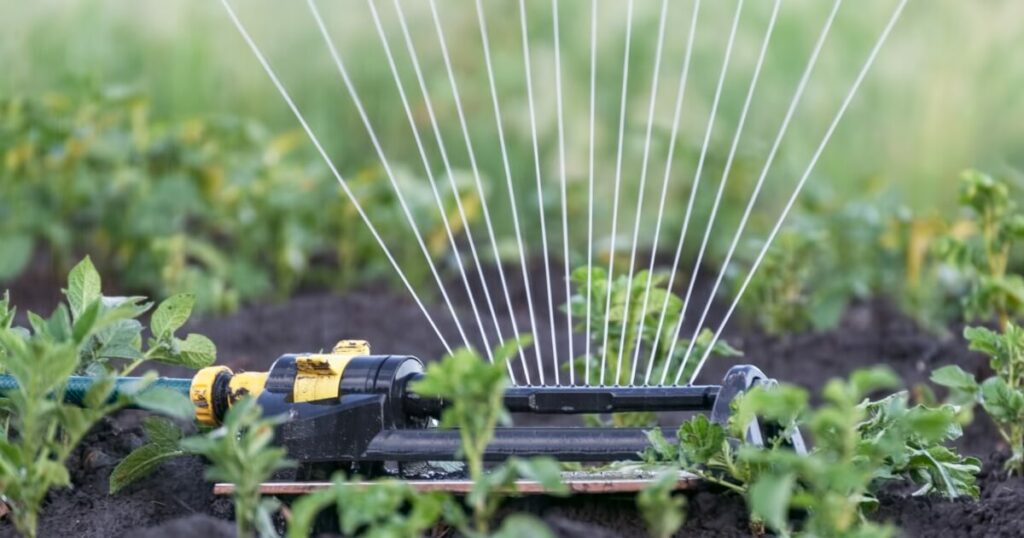
If you don’t have one yet, the Eden Oscillating Sprinkler is a great place to start. It has various settings and a cleaning tool, but the thing I love the most about it is that it has a heavy base to keep the sprinkler in place. Sometimes, with lighter sprinklers, a change in the flow of water can knock them over or move them over time.
TYPES
- Oscillating Sprinklers: These have a bar with several holes that move back and forth, showering water over a wide rectangular area.
- Rotating Sprinklers: They give an even 360-degree showering.
- Stationary Sprinklers: Perfect for small or specific areas in your garden that need targeted watering, like a group of plants or a small vegetable patch.
- Traveling Sprinklers: These self-propelled sprinklers give even coverage without needing to manually move the sprinkler.
BEST USES
- Oscillating Sprinklers: Best for newly seeded lawns, tender seedlings, and fragile flowers.
- Rotating Sprinklers: Ideal for larger, established gardens with a variety of plants.
- Stationary Sprinklers: Great for small garden patches or targeted areas.
- Traveling Sprinklers: Excellent for extensive gardens or large, open lawns.
Regular checks are important. Inspect hoses and connectors for leaks that can undermine water efficiency. Adjust as needed to ensure even coverage without dry spots or flooding.
Garden Cart
When it’s time to move heavy loads around the garden, I’ve found that a garden cart is better than a wheelbarrow for stability and can do most jobs just as well.
Sure, a standard wheelbarrow’s slim profile might be more practical for smaller gardens with narrow paths.
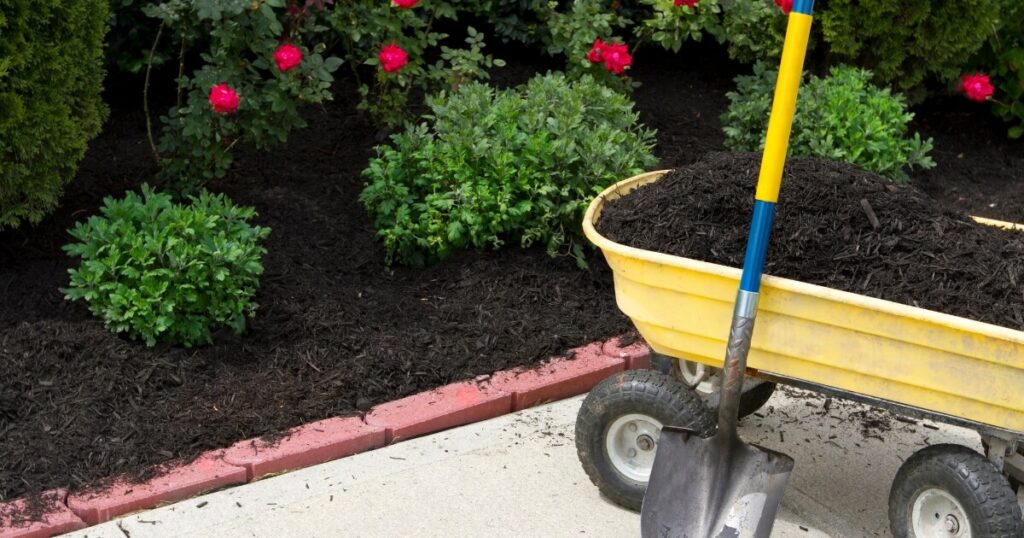
But if you’re working on uneven ground or have larger areas to cover, a four-wheeled cart provides better stability and can reduce strain as you don’t have to balance the load yourself.
If you’re on a budget, then a regular wheelbarrow is typically cheaper than a cart. But if you’ve got a bit extra, I suggest taking a look at The Gorilla Carts Dump Cart. It sits high off the ground and has a great dump feature, which is lacking in many cheaper models. To be honest, I’m not sure what else they could improve on other than the price.
Oh, and think about storage. Where will you keep it when not in use? I suggest locking it up somewhere safe.
TYPES
- Standard Wheelbarrows: These have one wheel at the front and are designed for easy maneuvering in tight spaces.
- Two and Four-wheeled Carts: Offering more stability, these are less likely to tip over and can handle heavier loads.
BEST USES
- Transporting Soil: Both types can carry hefty amounts of dirt from one spot to another with minimal effort.
- Moving Plants: Safely relocate large plants or multiple seedlings in one go.
- Carrying Tools: Keep all your gardening gear in one place as you move around your space.
Remember that while these tools do the heavy lifting, loading them properly is still important! Distribute weight evenly and don’t overload. It’s better to take an extra trip than risk a spill or hurt yourself.
Selecting the right gardening tools is a smart move that pays off in spades (pun definitely intended). Whether you’re a seasoned pro or just getting your gloves dirty for the first time, investing in quality tools makes every task more efficient and enjoyable.